Chevrolet
Impala Spark Plugs Replacement Guide
How to change the spark plugs in a 10th
generation 2014 to 2018 GM Chevy Impala with the Ecotec 2.5L I4 engine.
By Paul B. Michaels Author & Photographer Auto Mechanic Since 1989 |
||
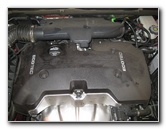 2014 Impala Ecotec LKW |
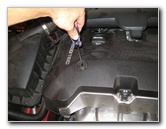 Loosen Counterclockwise |
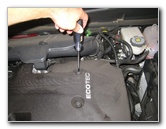 Three Engine Cover Screws |
| This
automotive maintenance tutorial was specifically written to assist
owners of the tenth generation (2014, 2015, 2016, 2017 and 2018) GM
Chevy Impala in checking or changing the engine spark plugs in the
Ecotec LKW DOHC 2.5 liter inline four cylinder motor. Owners of other General Motors vehicles such as the Malibu, Cruze, Camaro, Sonic, Spark, Volt, Corvette, Trax, Equinox, Traverse, Tahoe, Suburban, SS Sedan, Bolt, Colorado, Silverado, Buick Verano, Regal, LaCrosse, Cascada, Encore, Envision, Enclave, Canyon, Sierra 1500, Terrain, Acadia, Yukon, Savana, ATS, CTS, XTS, CT6, XT5, SRX and Escalade may also find these DIY instructions to be helpful. The OEM iridium spark plugs are ACDelco 41-115 (also known as GM part # 1267160). A few other compatible replacement spark plugs with their part numbers are as follows: Autolite XP5363, NGK 5019 LTR5GP, NGK 4344 LTR5IX-11, Champion RE10PYPB5 7437 and Pulstar ef1h10. The tools and other items needed to complete this procedure include a Torx T30 star bit screwdriver, a 10mm socket with a 1/4" drive ratchet, a 5/8" spark plug socket, a 6" extension bar, a 3/8" drive ratchet and a tube of dielectric grease. |
||
|
|
||
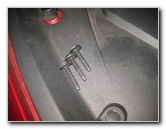 Three Torx T-30 Screws |
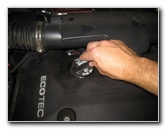 Twist Off Oil Filler Cap |
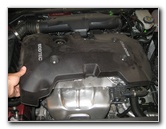 Lift Off Plastic Engine Cover |
| The first step is
to open the hood. Then remove the three screws on the plastic engine cover by turning them counterclockwise with a Torx T-30 star bit screwdriver. Set the three screws aside in a safe place. Spin off the oil filler cap in the counterclockwise direction and set it aside in a safe place. Gently lift the plastic cover off the top of the engine and set it aside with the screws and filler cap. |
||
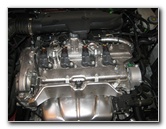 Engine Cover Removed |
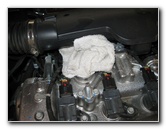 Plug Oil Filler Hole |
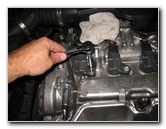 Loosen Ignition Coil Bolt |
| Place a clean towel
in the oil filler hole to help prevent from having debris fall down in to
the engine. If you have access to compressed air or a wet/dry shop vacuum, thoroughly clean off the top of the engine to help further reduce the risk of having something fall in to the spark plug wells. I recommend only checking or changing one spark plug at a time. Loosen the single bolt that secures the ignition coil to the top of the engine by turning it counterclockwise with a 10mm socket and a 1/4" drive ratchet. |
||
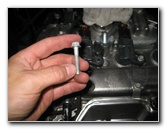 10mm Bolt Removed |
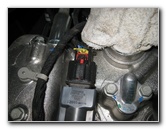 Ignition Coil Power Plug |
 Slide Out Red Lock Tab |
| Set the 10mm bolt
aside in a safe place. Slide out the red tab on the electrical connector to unlock it. |
||
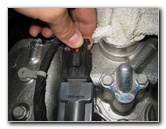 Push Down Release Tab |
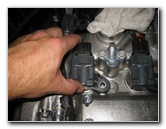 Rotate Back & Forth |
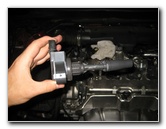 Lift Out Ignition Coil |
| Press down the
release tab on the power plug before sliding it straight off the end of the
ignition coil housing. Rotate the ignition coil back and forth a few times to make sure that the rubber dust boot at the bottom is not stuck or "frozen" to the top of the old spark plug. Lift the ignition coil out of the spark plug well and set it aside in a safe place. |
||
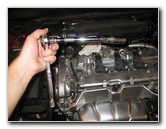 5/8" Socket & 6" Extension |
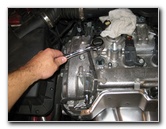 Loosen Counterclockwise |
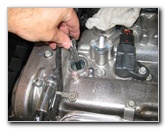 Spin Out Old Spark Plug |
| Attach the 5/8"
spark plug socket to the 6" extension bar and the 3/8" drive ratchet. Carefully loosen the old spark plug by rotating the ratchet in the counterclockwise direction. Try to avoid using excessive force to loosen the old spark plug to prevent from cracking the ceramic portion of the plug. If you have trouble loosening the old spark plug, spray a small amount of penetrating oil such as PB Blaster, Liquid Wrench or Kano Kroil and wait at least 15 to 30 minutes before trying to loosen it again. If you don't have any penetrating oil, try spraying some WD-40 or warm up the engine for about 10-15 minutes to expand the metal engine block. Once the old spark plug is loose, detach the ratchet from the extension bar and spin it out the rest of the way by hand. |
||
|
|
||
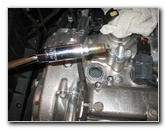 Lift Out Old Spark Plug |
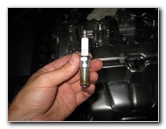 Inspect OEM Spark Plug |
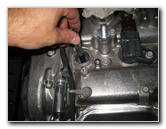 Spin In New Spark Plug |
| Lift the old spark
plug out of the well and detach it from the socket. Inspect both ends of the old spark plug. If the electrode end of the old spark plug looks ashy white, the plugs may have been exposed to high temperatures such as overheating or they could be the incorrect heat range for your driving conditions or local climate. On the other hand, if the old spark plug is dark grey or coated in black soot, the engine might be burning oil and should be examined by a professional mechanic. I recommend buying the OEM ACDelco 41-115 iridium tipped spark plugs (also known as GM part # 1267160). An optional step is to apply some anti-seize lubricant grease to the threads on the new spark plug. Most spark plug manufacturers recommend that you should not use anti-seize since it can easily lead to over tightening. If you have a spark plug gap gauge, verify that the gap on the new spark plugs match the manufacturer's specifications on the box. The OEM ACDelco 41-115 spark plugs should be gapped to .043". Push the new spark plug in to the 5/8" socket and lower it down in to the well. Spin the new spark plug by hand in the clockwise direction until it makes contact with the cylinder head. Tightening the spark plug at first by hand will help prevent it from becoming cross threaded. |
||
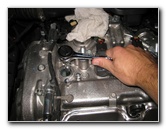 Tighten Clockwise |
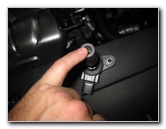 Apply Dielectric Grease |
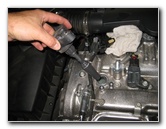 Re-Insert Ignition Coil |
|
Attach the 3/8" drive ratcheting wrench to the 6" extension bar and continue tightening the new spark plug in the clockwise direction. If you are re-installing the old spark plug, just tighten it to a small fraction of a turn past hand tight. If you are installing a new spark plug, tighten it to just past the point when you feel the new crush washer collapse. Do not over tighten the spark plug to prevent from cracking the ceramic body or stripping the aluminum threads. (If you applied anti-seize grease lubricant to the new spark plug, be very careful to not over tighten the spark plug.) Double check that the new spark plug is tight before moving on to the next steps. Apply some dielectric grease to the opening in the rubber dust boot at the bottom of the ignition coil housing. The dielectric grease will help keep out any moisture or debris to ensure a reliable electrical connection. Lower the ignition coil in to the housing and rotate it back and forth a few times to help spread the dielectric grease. |
||
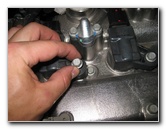 Spin In 10mm Bolt |
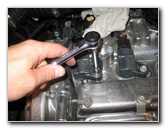 Tighten 10mm Clockwise |
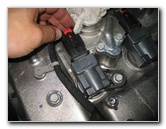 Push On Power Plug |
| Re-insert the
ignition coil bolt and spin it in a few turns in the clockwise direction to
prevent it from becoming cross threaded. Tighten the bolt in the clockwise direction with the 10mm socket and a 1/4" drive ratchet until it is snug. Try to avoid over tightening the 10mm bolt to prevent from cracking the plastic ignition coil housing. Push the power plug on to the end of the ignition coil until it clicks securely in to place. |
||
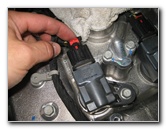 Slide In Red Locking Tab |
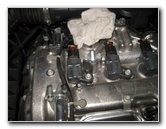 Spark Plug Replaced |
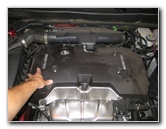 Lower Engine Cover |
| Push in the red tab
to lock the electrical connector. Remove the towel from the oil filler hole. Lower the plastic engine cover down in to place. |
||
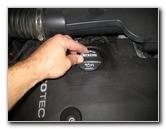 Spin On Oil Filler Cap |
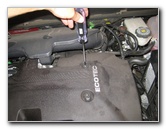 Replace T-30 Screws |
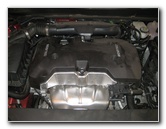 Engine Cover Replaced |
| Replace the oil
filler cap by twisting it on in the clockwise direction. Re-insert the three screws and tighten them in the clockwise direction with the Torx T-30 star bit screwdriver. Try to avoid over tightening the screws to prevent from cracking the plastic engine cover. Start the engine and listen for any strange noises that might indicate a problem such as a loose spark plug or a disconnected ignition coil power plug. Don't forget to record the spark plug change in your car's service records. For more, check out all of my
2014-2018 Chevrolet Impala DIY Repair & Maintenance Guides. |
||
| If you found this guide to be helpful,
please consider making a small donation by clicking on the PayPal.com
"Donate" button located to the right of this paragraph. Thank you!
(Note: I am not a registered charity. Donations are not tax deductible.) |
Copyright 2024 © PaulsTravelPictures.com
All Rights Reserved ®
| Paul's Travel Pictures is a participant in the Amazon Services LLC Associates Program, an affiliate advertising program designed to provide a means for sites to earn advertising fees by advertising and linking to Amazon.com. |
Privacy Policy About Paul & Author Contact Info

